
The Battery is a landmark defensive seawall and promenade in Charleston, South Carolina. Named for a civil-war coastal defense artillery battery at the site, it stretches along the lower shores of the Charleston peninsula, bordered by the Ashley and Cooper Rivers, which meet here to form Charleston harbor.
Rainbow Row is the name for a series of thirteen colorful historic houses in Charleston, South Carolina. The houses are located north of Tradd St. and south of Elliott St. on East Bay Street, that is, 79 to 107 East Bay Street. The name Rainbow Row was coined after the pastel colors they were painted as they were restored in the 1930s and 1940s. It is a popular tourist attraction and is one of the most photographed parts of Charleston.

The James Simmons House is a late 18th-century house at 37 Meeting Street, Charleston, South Carolina which was, at one time, the most expensive house sold in Charleston. It was likely built for James Simmons, a lawyer. By 1782, it was home to Robert Gibbes, a planter. Louisa Cheves, a prominent antebellum writer, was born at the house on December 3, 1810. In 1840, Otis Mills, the owner of the Mills House Hotel, bought the house for $9,000. In October 1862, during the Civil War, the house was loaned to Gen. Pierre Beauregard, who used the house as his headquarters until August 1863. In 1876, Michael P. O'Connor, later a member of Congress, bought the house.

The Rev. Robert Smith House is a pre-Revolutionary house at 6 Glebe St., Charleston, South Carolina which is used as the official residence for the president of the College of Charleston. The present use is an odd twist of history; Rev. Robert Smith, whose name has been given to the house, was the first Episcopal bishop of South Carolina and was also himself the first president of the College of Charleston.

The Ralph Izard is a pre-Revolutionary house at 110 Broad St., Charleston, South Carolina. Although the house is known as the Ralph Izard House, it was likely built by a former owner, William Harvey. The house was listed in the will of Izard of September 1757, but Izard had only acquired the parcel three months before his death.
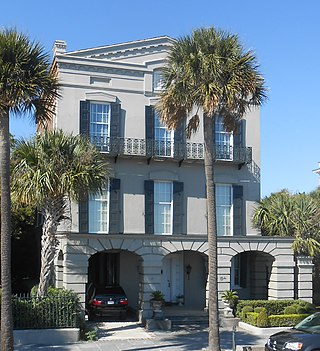
The William Ravenel House is an historic house in Charleston, South Carolina, United States.

The William Harvey House in Charleston, South Carolina, is one of three tenement houses near the southeast corner of Meeting and Tradd Streets that were described in the local newspaper as "newly built" on April 19, 1770.

The Elias Vanderhorst House at 28 Chapel Street, Charleston, South Carolina, is a four-story mansion house which was built around 1835 as a home for members of the prominent Vanderhorst family of plantation owners.
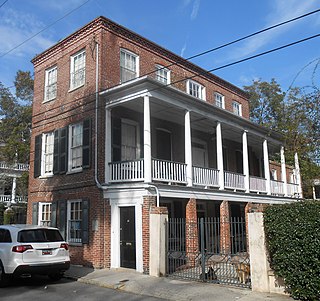
The Chazal House is a Greek Revival house at 66 Anson St., Charleston, South Carolina in the historic Ansonborough neighborhood.
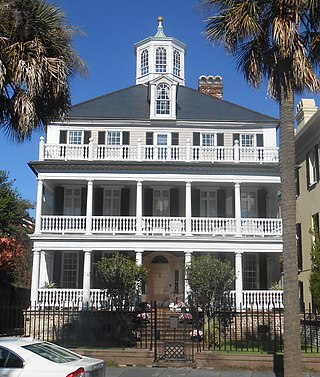
The John Ashe House is an 18th-century house at 32 South Battery, Charleston, South Carolina. The house's date of construction is unknown, but it was built sometime around 1782 and renovated in the 1930s. In August 2015, it replaced the James Simmons House as the most expensive house sold in Charleston when it fetched about $7.72 million.

The John Drayton House is a two-story wooden residence constructed on property that had been given by the state's first lieutenant governor, William Bull, to his son-in-law, John Drayton. The house was built, probably by John Drayton, some time after 1746 with alterations made in about 1813 and again in about 1900. Over time, the house has been attributed to different owners; during most of the 20th century, the house was credited to James Shoolbred, the first British consul in Charleston, with a construction date of about 1793.

The Capers-Motte House is a pre-Revolutionary house at 69 Church Street in Charleston, South Carolina. The house was likely built before 1745 by Richard Capers. Later, the house purchased and became the home of Colonel Jacob Motte, who served as the treasurer of the colony for 27 years until his death in 1770. His son, also named Jacob Motte, married Rebecca Brewton, daughter of goldsmith Robert Brewton and sister of Miles Brewton, a wealthy slave trader.
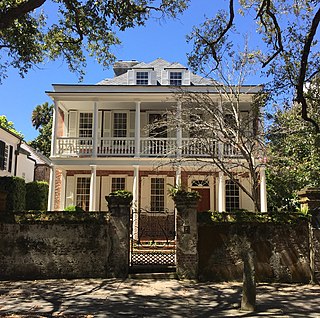
The George Eveleigh House is a pre-Revolutionary house in Charleston, South Carolina. The house was built about 1743 for trader George Eveleigh. Eventually, Eveleigh returned to England and sold his house to John Bull in 1759. John Bull or one of his heirs subsequently built the house at 34 Meeting Street on the rear of the property; the parcel had originally run from Church Street through the block to Meeting Street on the west. The house retains much of its original cypress woodwork although many of the fireplace mantels were replaced in the Adam period.
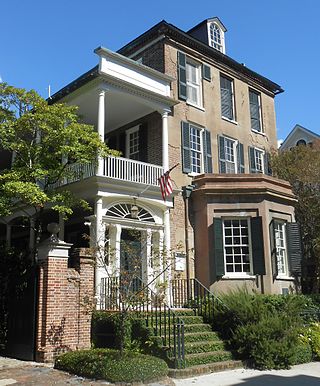
The Robert Pringle House is a historic house in Charleston, South Carolina.

The Daniel Legare House is the oldest surviving house in the historic Ansonborough area of Charleston, South Carolina. The land upon which the house was built was sold to Daniel Crawford in May 1745 for a price that was much lower than expected for a house at the time, thereby suggesting a construction date after that time.
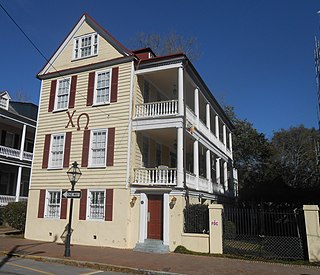
The John Scott House at 38 Coming Street is one of the two oldest buildings on the Charleston, South Carolina campus of the College of Charleston.

The Daniel Elliott Huger House was the last home of a Royal governor in South Carolina.

The John Edwards House in Charleston, South Carolina was built in 1770 by Colonial patriot John Edwards. During the Revolutionary War, half of the house was used by British admiral Mariot Arbuthnot as his headquarters, while the Edwards family was allowed to remain in the other half.

The Dr. Henry Frost Office at 98 Broad Street is composed of a front portion that appears to date from the mid-19th century and a rear portion that appears to be much older. The land upon which 98 Broad Street was built was owned by famous loyalist and horticulturalist Alexander Garden when he was forced to abandon the property when Charleston fell to the colonial forces in 1782.
The John Schnierle House is an antebellum house in Charleston, South Carolina that was the home of Mayor John Schnierle.



















